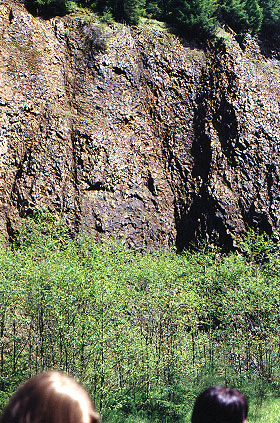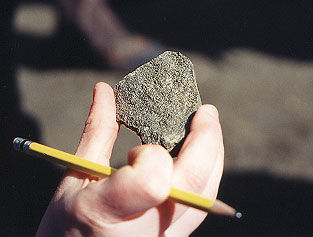
An almost vertical face of what appears to be an intrusive basaltic dike that has been exposed in this highway cut. We are looking across the highway and above the tops of young birch that have grown up along the base of the engineered talus slope. Our fearless leader talks us out of brush bucking to gather specimens.
This is columnar jointed plutonic rock that is laying on its side. Jointing results from the cooling and solidifying process which took place in a fault or between layers of sedimentary rock identified as a Sweet Home Creek member of the Hamlet formation. This intrusive bed is younger, we are told, than the sediments on either side of it. We are looking at the cross sections of the columns, which could be mistaken for entablature or brick-laid jointing. Later we are told that this is more accurately recognized as a sill rather than a dike, and that the formation has been upturned 90 degrees.

These Cole Mountain Basalts appear to be part of the Gobel diabase, mid-way between a gabbro and a basalt. We are told that the This specimen, gathered on a previous field trip, shows specular highlights of small crystals of plagioclase feldspar and dark crystals of pyroxene. This coarse-grained matrix is indicative of slow cooling, below the surface. The small size of crystals however, leads me to believe that the sill was not terribly deep, perhaps a surface fracture-zone intrusion.